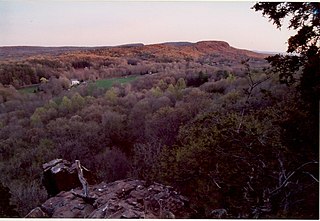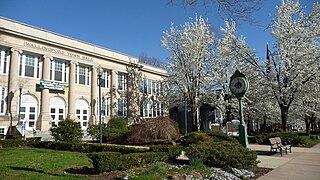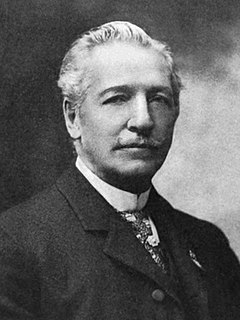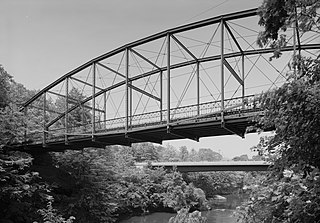
Berlin is a town in Hartford County, Connecticut, United States. The population was 20,175 at the 2020 census. It was incorporated in 1785. The geographic center of Connecticut is located in the town. Berlin is residential and industrial, and is served by the Amtrak station of the same name. Berlin also has two hamlets: Kensington and East Berlin.

Southington is a town in Hartford County, Connecticut, United States. As of the 2020 United States Census, it had a population of 43,501. Southington contains the villages of Marion, Milldale, and Plantsville.

Wallingford is a town in New Haven County, Connecticut, United States, centrally located between New Haven and Hartford, and Boston and New York City. The population was 44,396 at the 2020 census. The community was named after Wallingford, in England.

A blacksmith is a metalsmith who creates objects primarily from wrought iron or steel, but sometimes from other metals, by forging the metal, using tools to hammer, bend, and cut. Blacksmiths produce objects such as gates, grilles, railings, light fixtures, furniture, sculpture, tools, agricultural implements, decorative and religious items, cooking utensils, and weapons. There was an historical distinction between the heavy work of the blacksmith and the more delicate operation of a whitesmith, who usually worked in gold, silver, pewter, or the finishing steps of fine steel. The place where a blacksmith works is called variously a smithy, a forge or a blacksmith's shop.

A carriage is a private four-wheeled vehicle for people and is most commonly horse-drawn. Second-hand private carriages were common public transport, the equivalent of modern cars used as taxis. Carriage suspensions are by leather strapping and, on those made in recent centuries, steel springs. Two-wheeled carriages are informal and usually owner-driven.

An anvil is a metalworking tool consisting of a large block of metal, with a flattened top surface, upon which another object is struck.

The Brass Era is an American term for the early period of automotive manufacturing, named for the prominent brass fittings used during this time for such things as lights and radiators. It is generally considered to encompass 1896 through 1915, a time when these vehicles were often referred to as horseless carriages.

Francis Ashbury Pratt was an American mechanical engineer, inventor, and co-founder of Pratt & Whitney.

Amos Whitney was a mechanical engineer and inventor who co-founded the Pratt & Whitney company. He was a member of the prominent Whitney family.

Charles Ethan Billings (1834–1920) was an American mechanical engineer, inventor, superintendent, and businessman. He held various U.S. patents on hand tools, either assigned or licensed to the firm that he and Christopher M. Spencer cofounded, the Billings & Spencer Company. His name as patent holder is stamped on countless forged hand tools, many of which survive. Billings was an expert in drop forging and was an influential leader in the American system of manufacturing and its successor systems of mass production for firearms, sewing machines, hand tools, bicycles, and other goods. He served as president of the American Society of Mechanical Engineers in 1895 and 1896. The Billings & Spencer Company was both a machine tool builder and a manufacturer of hand tools made with its machine tools.

The Litchfield Law School of Litchfield, Connecticut, was the first independent law school established in America for reading law. Founded and led by lawyer Tapping Reeve, the proprietary school was unaffiliated with any college or university.

Suffolk County Historical Society Building is a museum and library dedicated to preserving historic artifacts of Suffolk County, New York, as well as other parts of Long Island. It is located at 300 West Main Street as well as Osborn Avenue and Court Street in Riverhead, New York.

Charles H. Black was an American carriage wagon maker and automobile leader whose business was in Indianapolis, Indiana. As a skilled blacksmith craftsman and designer of carriage wagons, he was led into the idea of making a self propelled vehicle that would run under its own power. Black first produced a steam engine self powered vehicle. He improved on this technology and, in 1891, produced a vehicle that used a single-cylinder 18 horsepower gasoline engine. He drove this vehicle around Indianapolis for twenty years as his own personal car.

The Berlin Iron Bridge Company was a Berlin, Connecticut company that built iron bridges and buildings that were supported by iron. It is credited as the architect of numerous bridges and buildings now listed on the U.S. National Register of Historic Places. It eventually became part of the American Bridge Company.

Warren R. Briggs (1850–1933) was an American architect who worked in Bridgeport, Connecticut.
Snap-on Industrial Brands, historically the J.H. Williams Tool Group, is a division of American hand tool manufacturer Snap-on that makes and distributes tools to industrial markets. In addition to the Williams brand from which it originated, the group includes Bahco and CDI Torque Products.

George W. Longstaff (1850-1901) was an American architect practicing in Bridgeport, Connecticut.

The H. D. Smith Company Building is a historic industrial building at 24 West Street in Plantsville, Connecticut. With a construction history dating to 1882, it is one of the more architecturally interesting examples of Southington's industrial architecture, and was home to H. D. Smith & Co. from construction to the 1920s. It was listed on the National Register of Historic Places in 1977.

H. Edwards Ficken (1852-1929) was an English American architect in practice in New York City.



















